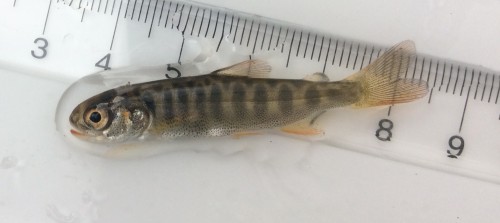SPECIES ID / Freshwater Fish of the Fraser Valley
Salmon/Trout/Char (Salmoninae)
Chinook Salmon
Tl'élxxel
Oncorhynchus tshawytscha
Identification Tips:
Adults
• Silver coloured at sea; darker brown or olive or reddish in freshwater
• Irregular black spots on entire caudal (tail) fin (on top half only in Coho)
• Gums at base of lower jaw teeth are black in Chinook (white in Coho)
Juveniles
• Difficult to distinguish from Coho Salmon
• Anal fin rays all the similar in length in Chinook (front rays longer than rest in Coho, giving it a hooked or sickle shape)
• First ray of dorsal fin is dark in Chinook (white in Coho)
• Often white tip on dorsal fin in Chinook
• Clear 'window' and dark rear edge on adipose fin in Chinook, opaque centre and dark rim in Coho
• First ray of anal fin is clear or white (no black) in Chinook (white followed by black in Coho)
Conservation Status:
| British Columbia | Canada | Natureserve | |
| COSEWIC | Species at Risk Act | ||
| Not at Risk (Yellow List) | Not Assessed | None | G5, S4 |
Information Source: BC Conservation Data Centre: http://a100.gov.bc.ca/pub/eswp/
Life History:
• Spawn in fall at 2-7 years of age (most 3-5)
• Some males return as small, mature 'Jacks' after 6 months at sea
• Two life history types; Stream-type and Ocean-type
• Stream-type spend 1 to 3 years in freshwater, perform extensive offshore ocean migrations, and return to rivers in spring or summer for several months prior to spawning
• Ocean-type migrates to sea within months of emerging from gravel, stay in coastal areas and migrate to to spawning rivers immediately before spawning.
Habitat:
• Often spawn in larger streams and over coarser gravel than other salmon, but may use small streams
Stream-type
• Juveniles rear in main rivers, large tributaries and sometimes lakes
• May overwinter in off-channel ponds or in slow moving water close to cover
• Migrate to estuaries after 1 year and are found near shore until mid-summer, when they move offshore
• Adults hold in deep pools in rivers over the summer prior to spawning
Ocean-type
• Rear in estuaries close along marsh edge at high tide and in small tidal channels at low tide
Range:
British Columbia
• Found in most medium to large rivers along the coast
• May ascend hundreds of km to spawn.
• Many rivers contain more than one run (population)
Global
• Northeaster Asia, including northern Japan
• Northern Alaska south to central California
Comments:
• A highly prized food fish
• Often referred to as 'Spring Salmon'; also 'Tyee' or 'King Salmon'
––––––
Primary Information Source:
McPhail, J.D. 2007. The Freshwater Fishes of British Columbia. University of Alberta Press. Edmonton, Alberta.



